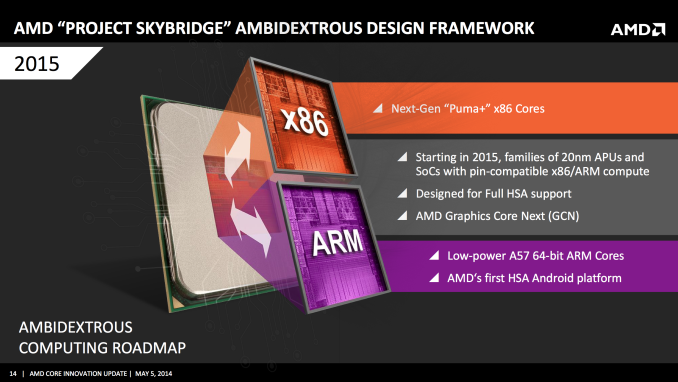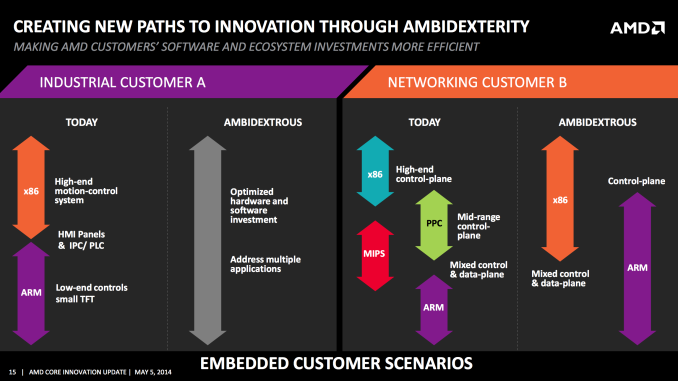AMD Announces Project SkyBridge: Pin-Compatible ARM and x86 SoCs in 2015, Android Support
by Anand Lal Shimpi on May 5, 2014 12:45 PM EST
This morning AMD decided to provide an update on its CPU core/SoC roadmap, particularly as it pertains to the ARM side of the business. AMD already committed to releasing a 28nm 8-core Cortex A57 based Opteron SoC this year. That particular SoC is aimed at the enterprise exclusively and doesn't ship with an on-die GPU.
Next year, AMD will release a low-power 20nm Cortex A57 based SoC with integrated Graphics Core Next GPU. The big news? The 20nm ARM based SoC will be pin compatible with AMD's next-generation low power x86 SoC (using Puma+ cores). The ARM SoC will also be AMD's first official Android platform.
I don't expect we'll see standard socketed desktop boards that are compatible with both ARM and x86 SoCs, but a pin compatible design will have some benefits for embedded, BGA solutions. AMD expects to target embedded and client markets with these designs, not servers.
AMD's motivation behind offering both ARM and x86 designs is pretty simple. The TAM (Total Addressable Market) for x86 is decreasing, while it's increasing for ARM. AMD is no longer married to x86 exclusively and by offering OEMs pin compatible x86/ARM solutions it gets to play in both markets, as well as benefit if one increases at the expense of the other.
Note that we're still talking about mobile phone/tablet class CPU cores here (Cortex A57/Puma+). AMD has yet to talk about what it wants to do at the high end, but I suspect there's a strategy there as well.












34 Comments
View All Comments
sonofliberty - Monday, May 5, 2014 - link
just wait until all those lazy programmers update their code to ARM then is time for us to leave the aging crappy x86 to Intel aloneMikhailT - Monday, May 5, 2014 - link
Intel's already fab'ing ARM chips (http://www.anandtech.com/show/7473/intel-to-fab-al... and they used to own StrongARM and still owns some XScale families.Intel has an arch license for ARM, so they can join the market with a lead over ARM quicker than we would suspect.
They're not going to sit on their butt with x86. If the market decides to switch over to ARM for everything (unlikely), Intel will start producing ARM chips quickly and will have an advantage as they still have 2-4 years worth of lead over the process technologies than everybody else.
testbug00 - Monday, May 5, 2014 - link
Intel's fab "advantage" is smaller than most people are led to believe... since 65nm they have been doing what TSMC/GloFo/Samsung are doing now. GloFo and TSMC 28nm compete with Intel's "22nm" in density quite well, while losing in other areas... but, those other areas are likely due more to finFETs.That leaves Intel with a product they cannot sell for margins close to what their current lineup sells for, while also having to pay the same for fabs (mostly fixed costs) with smaller chips resulting in them utilizing even less of what they have.
Intel's biz. model does not work with ARM... Qualcomm's top end chips sell for less than Intel's lowest end chips (well, with Contra revenue that might not be true) (iirc).
Krysto - Monday, May 12, 2014 - link
Intel is not going to join ARM. They failed before and they would fail now. Why do you think they sold Xscale? Because it was going so well for them?If they join ARM that would send a strong indicator to the market that they're "dumping" x86 (whether they admit to it later or not) - and then it would become a self-fulfilling prophecy and everyone would dump x86. Intel does not want that because their big profits are in high-end x86 chips (at least for now).
The only way they are even convincing some clueless OEMs to adopt their Atom chips is because they are HEAVILY subsidizing them to match ARM chip prices, while they are barely competitive in CPU performance, and a full generation behind in GPU performance, even with a half-node advantage + Trigate. They're losing $1 billion every quarter with Atom right now.
vailr - Monday, May 5, 2014 - link
Maybe the idea would be: run Android on the cell phone, and also have the ability to dual-boot + run full Windows (or other x86 operating system: Linux, OSX). Include a built-in mini-sized wall projector on the side of the phone, and you'd have a laptop replacement + decent adjustable sized display for portable Windows usability. Sub par "screen quality", but still usable. Carry a wallet-sized foldable full sized bluetooth keyboard + mini mouse.Thohean - Tuesday, May 13, 2014 - link
Fujitsu LOOX F-07C already does this with the atom. It dual boots Window 7 and Symbian.http://www.gsmarena.com/fujitsu_loox_f07c_dualboot...
TristanSDX - Monday, May 5, 2014 - link
Thanks to Intel, x86 wont be decreasing, but increasing. AMD speculations refres only to AMD x86 crap. If they cannot make competitive x86 with decades of experience, then they won't make competitive ARM, and their magic formula 'if we don't sell x86 then we sell ARM' will not work. There are other succesfull ARM competitors, more dangerous for AMD on ARM battlefield than Intel on x86.purerice - Monday, May 5, 2014 - link
Good point. Combine that with a stretching of limited resources and they could have two losing markets. Besides, this seems more like a feature that they are trying to turn into a product. They are way behind on the CPU front and even with HSA, or perhaps all the more because of it, they need to work to catch up in their core business instead of trying to outfeature competitors with something that is out of their expertise.tcube - Tuesday, May 6, 2014 - link
Nothing furter from the reality. You forget amd does NOT have the printing the chips problem. And ARM already provides the schematics for the cores with the licence. So all amd needs to do is optimise and slap in their graphics core and send it to the "printer".Intel however has to deal with the entire process not being a multiple design business model like the rest of the fab world it would be a huge organisational change... amd doesn't know about such problems... one fabber can't build it no problem go to another. This is overly simplified but it still holds true.
As to expertise... you really compare arm to amd?? You really think that amd is not capable of building a much better arm then arm itself when designers with less experience like qualcomm and apple did it?? Are you on the moon?? Amd has proabably the biggest chip design pattent portfolio in the world probably toppes only by ibm's research labs. To put it into perspective intel LEASES all the gpu patents from nvidia for a LOT of money. Amd doesn't need to. Amd has also loads of memory patents and many many others. So... what was your concern again?? That they can't build a 10x simpler chip then any modern x86 chip... you are really ... really funny.
Both intel and amd can build arm chips while half asleep drinking coffeeand shagging at the same time... the problem for intel is NOT design after given specs... but addapting the business model and theyr fab processes to support large variations in designs. If you will it's the transition from enormously long conveyourbelt assembly lines to small robotic assembly stations... they are simply not eqipped to do it the way tsmc, glofo and now samsung are doing it.
As to your claim that they are behind...
Beema/mullins chips perform similarly x86 wise to intels offerings (in regard to TDP) and at the same time being almost a factor better graphics... still standing in the same power envelope... being on 28nm vs intels 22nm... so... if 22nm process advantage was nullified by amd with this chip... what do you think they'll do on samsungs 14nm process that glofo will use and amd will profit from?? Talk about expertise... what a clown...
testbug00 - Monday, May 5, 2014 - link
AMD has more experience fully designing CPUs than all companies in the ARM space to my knowledge.Well, perhaps less than ARM holdings. It really depends on if AMD takes a NVidia "just throw a GPU onto an ARM core" or the Qualcomm route "fully custom, aimed at low power" and, as we can clearly see, they choose the Qualcomm route.
I don't expect AMD to be the best ARM manufacturer, but, they should be able to compete with every large company in the space, except perhaps Qualcomm.